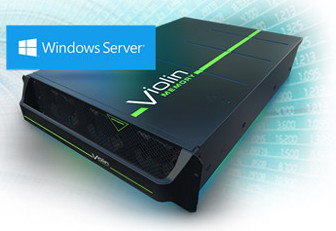Violin Windows Flash Array Delivers Scale-Out NAS File System Performance
2 million random read IO/s and 1.6 million random write IO/s on 2-node NAS cluster
This is a Press Release edited by StorageNewsletter.com on December 17, 2014 at 2:52 pmBased on Violin’s Windows Flash Array (WFA), this solution has delivered linear scalability to more than 2 million random read IO/s and 1.6 million random write IO/s on a 2-node NAS cluster.
Microsoft‘s white paper – Building High Performance Storage for Hyper-V Cluster on Scale-Out File Servers using Violin Windows flash Arrays, published in October 2014 – details several user deployments that benefit from the performance, scalability, data services capabilities and availability of Violin’s WFA scale-out tier-1 NAS solution.
In particular, the Microsoft white paper focuses on how the WFA’s scale-out NAS capability delivers value to customers using Hyper-V on scale-out file servers with resiliency, availability, scalability and performance. With Violin enterprise all-flash arrays, Microsoft’s SMB Direct interconnect, and Windows Server 2012 R2, scale-out NAS is well-positioned for delivering a scale-out file server solution.
In addition, the WFA supports NFS 3.0 and NFS 4.1 for connectivity with application servers running OSs such as Linux and UNIX. NAS scale-out file shares on the WFA are simultaneously available as Windows file shares over SMB 3 and as NFS exports to simplify data sharing across the data center. There are no artificial data silos separating SMB- and NFS-based applications with the WFA – just integration of high performance, easily accessible all-flash storage.
Jointly developed with Microsoft Corp., the WFA is an all-flash array solution powered by Windows Server 2012 R2 to deliver a set of storage features and data services for scale-out tier-1 NAS deployments. The performance of the WFA transforms data center economics by reducing CAPEX, OPEX, and TCO for enterprise NAS environments.
“WFA provides a tier-zero and tier-1 scale-out NAS all-flash array for enterprise Microsoft deployments,” said Jose Barreto, principal program manager, Microsoft. “Windows Server 2012 R2 combined with Violin’s all -flash array delivers an enterprise grade solution for our joint customers.“
“Service providers and other consumers of cloud-based infrastructure typically require both extremely high performance and continuous availability to meet demanding server level agreements,” said Eric Burgener, storage research director, IDC. “Violin Memory’s Windows Flash Array is well integrated with Windows Server 2012 R2 for ease-of-use, and in a scale-out file system cluster, delivers the performance, availability and scalability that allow these types of customers to meet extremely demanding requirements.“
The WFA enables tier-1 NAS workloads, as well as SQL Server, SharePoint, and Windows Server with Hyper-V for both server and desktop virtualization. The enterprise-wide scale-out file services meets the needs of global enterprises, while refocusing IT expenditure towards business innovation.
The WFA offers a set of capacity points, as well as pay-as-you-grow capacity licensing model for optimum solution delivery. Customers also have a choice in how they interconnect the all-flash scale-out NAS array with their existing infrastructures. The WFA supports either 56GB FDR IB or 10GbE. In both cases, customers benefit from the efficiency and high performance afforded by SMB Direct and the rest of the SMB 3.0 feature set.
“When Violin Memory and Microsoft teamed up to create the Violin WFA we knew they had a powerful solution. Microsoft’s white paper demonstrates the high performance, availability and scalability achieved in a scale-out file server cluster in a virtualized environment and further underscores the performance benefits associated with implementation in a virtualized data center.” said Brian Garrett, VP, ESG Lab.
“Wikibon was excited when Violin launched its WFAy because many practitioners in our community are looking for storage solutions that provide predictable performance and the higher availability that integration delivers. Microsoft’s research shows that customers can achieve high throughput and low latency while minimizing complexity at scale. This is particularly important in virtualized environments where IT pros demand efficiency and don’t want to pay a performance tax.” said David Vellante, chief research officer, Wikibon.














 Subscribe to our free daily newsletter
Subscribe to our free daily newsletter

